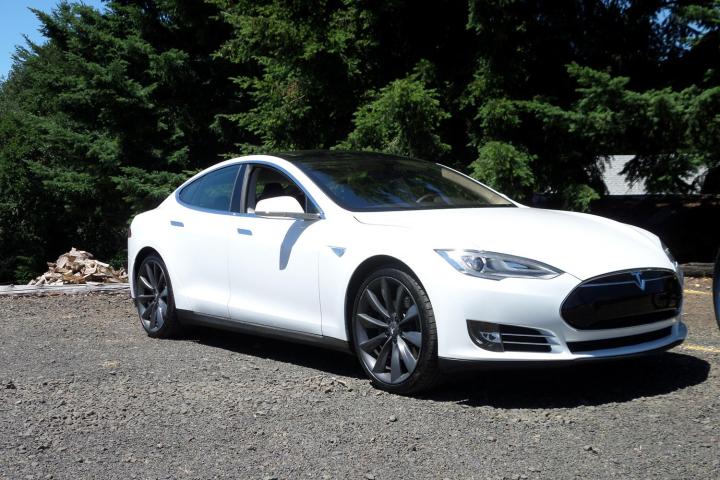
The hottest electric car on the market, the Tesla Model S, is changing people’s minds about driving an electric vehicle. Sure, it’s expensive, but we all know that the innovations in the Model S will eventually trickle down to less expensive cars and into the EV gene pool in general. Here are five properties of the Model S that signal big changes in the way we drive.
1. Smoothness counts more than ever
Smoothness is key to driving a Tesla in order to squeeze the maximum number of miles out of the battery. Since there’s no gas motor to rescue you if you run out of juice, drivers of the Model S have begun to adopt certain driving habits that preserve the car’s range – or extend it – in several ways. The first is by being smooth on the controls. Sure, it a gas (pun intended) to stomp on the Model S’ accelerator and crush that snob in the Viper with a 4.2-second 0-60 time that also pins you to your seat as a wave of torque propels the car ever faster, but smart drivers know those kind of hijinks are also range and battery power killers, so most owners have adopted a light-on-the-pedal approach to maximize range with a little fun mixed in when warranted. This is actually common for owners of most all electric and plug-in hybrid cars.
Additionally, planning stops ahead becomes an art for the sake of science. Coasting up to that stoplight and returning 100 percent of the regeneration power to the battery instead of inefficiently heating up the brake rotors gives Model S drivers more range, and if you can ride in regeneration mode down a big hill (counterintuitive, I know), your battery becomes very happy. Plus, you’re now a better, smoother driver that looks farther down the road.
2. Enjoy the silence
Get into the driver’s seat of a Tesla, turn off the audio system, put it in Drive, tap the accelerator and the Tesla moves forward – in total silence. At higher speeds, road noise comes through but the sound level continues to be lower since there’s no engine or transmission churning away, no exhaust pipes and very little wind noise. The car is so quiet it can sometimes “sneak up” on pedestrians in parking lots or crosswalks, so feel free to toot the horn a bit to give everyone a heads up if you’re at the wheel.
Get into most any gas-powered car after driving the Tesla and the vibration, noise and comparative crudeness of gas-powered transportation is immediately apparent. Automakers looking to compete with the Tesla have their work cut out for them in terms of making their cars more quiet, and from that we will all benefit.
3. It’s a smarter smart car
When going for a drive in the Tesla, there are no doors to unlock, keys to turn or Start buttons to push as long as you have the key fob on your person. Just sit down and drive, there’s no warming up or other delays. While driving, every iota of information you could desire including navigation, audio, the real Internet, car settings, driving dynamics, energy recapture and more is either on the central 17-inch vertical touchscreen or on the LCD screens flanking the central speedometer. There are almost no buttons in the car.
Once done with driving, put it in Park, get out and walk away. The door handles retract and the car turns itself off and locks down until you return. There are stories of Tesla owners who, after driving their Model S sedans for a while, drive gas powered cars and after parking, get out and walk away – leaving the car running in place.
4. You get more with less
As refined as they are today, gas-powered cars are extremely complicated. They have an engine with hundreds of moving parts, many of which wear out over time or can break, a transmission with hundreds more parts again as well as driveshafts, differentials and more, all of which can also wear out over time. The Model S has a simple watermelon-sized electric motor with relatively few moving parts and it has a one-gear “transmission” which is really just a simple gear to connect the rear wheel axles to the motor. Beyond that it has shock absorbers and a steering system. There is no exhaust system to rust out, no oil change schedule to follow, no DEQ inspections to suffer through and pay for and no tuneups needed outside of occasional tech checkups to make sure all is well. All that adds up to less complexity, less cost, less to go wrong and simpler fixes when they do.
5. It’s hard to buy gas after learning to drive without it
Electric vehicles like the Tesla still have to deal with where and when to charge up. But while it may take a Model S about 20 minutes to get an 80 percent recharge from a Tesla Supercharger (and that’s free, by the way), it’s a whole lot cheaper than dropping $50 to $100 on a tank of liquid dinosaur. Every week.
Many Tesla owners are happy to take a 20 or 30 minute break after driving 200 or so miles anyway. And with Tesla due to roll out a gas-station-like battery-swap option that takes 90 seconds to complete, they’ve kind of answered the recharge time question as well.
How else do you think the Model S has changed driving? Leave a comment below.
Editors' Recommendations
- The Tesla Model Y is at its lowest price yet — but should you buy one?
- Cybertruck production reportedly halted over pedal issue
- Rivian R2 vs Tesla Model Y: Can the R2 challenge the Model Y’s dominance?
- Here’s how Ford will give EV customers Tesla Supercharger access
- Some on Apple’s failed car project reportedly had a cruel name for it


